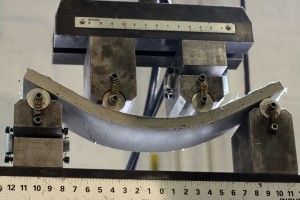Engineered Cementitious Composite (ECC), also called bendable concrete, is an easily molded mortar-based composite reinforced with specially selected short random fibers, usually polymer fibers. Unlike regular concrete, ECC has a strain capacity in the range of 3–7%, compared to 0.1 % for ordinary portland cement (OPC). ECC therefore acts more like a ductile metal than a brittle glass (as does OPC), leading to a wide variety of applications.
Flexible concrete might sound like a gimmick, but most concrete fails because it is brittle, so cracks develop over time, and eventually become catastrophic. Researchers has reduced this brittleness to make a concrete “500 times more resistant to cracking and 40 percent lighter.” They also say that for a typical application, it “is 37 percent less expensive, consumes 40 percent less energy, and produces 39 percent less carbon dioxide”.
ECC looks similar to ordinary portland cement-based concrete, except that it does not include coarse aggregate and can deform (or bend) under strain. A number of research groups are developing ECC science, including those at the University of Michigan, Delft University of Technology, the University of Tokyo, the Czech Technical University, and Stanford University. Traditional concrete’s lack of durability and failure under strain, both stemming from brittle behavior, have been a pushing factor in the development of ECC.
There are a number of different varieties of ECC, including:
- Lightweight (i.e. low density) ECC have been developed through the addition of air voids, glass bubbles, polymer spheres, and/or lightweight aggregate. Compared to other lightweight cements, lightweight ECC has superior compressive and tensile strength, crack-width control, and damage tolerance. Applications include floating homes, barges, and canoes.
- ‘Self compacting concrete’ refers to a concrete that can flow under its own weight. For instance, a self-compacting material would be able to fill a mold containing elaborate pre-positioned steel reinforcement without the need of vibration or shaking to ensure even distribution. Self-compacting ECC was developed through the use of chemical admixtures to decrease viscosity and through controlling particle interactions with mix proportioning.
- * Sprayable ECC, which can be pneumatically sprayed from a hose, have been developed by using various superplasticizing agents and viscosity-reducing admixtures. Compared to other sprayable fiber-reinforced composites, sprayable ECC has enhanced pumpability in addition to its unique mechanical properties. Sprayable ECC has been used for retrofitting/repair work and tunnel/sewer linings.
- An extrudable ECC for use in the extrusion of pipes was first developed in 1998. Extruded ECC pipes have both higher load capacity and higher deformability than any other extruded fiber-reinforced composite pipes.

